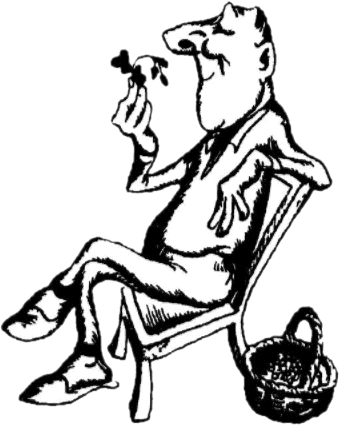107Stories About ChemistryINDEX |
85.
Aromas of a Wild Strawberry Patch
 ...A glade in a pine forest. A hot day in July. And strawberries, strawberries everywhere�ripe, rugged, bright red berries, so tasty, they melt in your mouth. But what do they smell of, these strawberries? You must confess that you have never stopped to think about it. You just enjoyed the aroma of the pine forest, the smell of the sunny glade. But odour is a very complex phenomenon. There is a whole science of odours. Scientists still have to work out a uniform opinion as to why some substances have a strong odour while others have hardly any; why some odours are pleasant, and others disgusting. There is no doubt that the odour of a substance is related to the structure of its molecules. But how? That is what we cannot say for certain. There is no strict physical theory of odours as yet. Chemists have an easier time of it. They can identify the different molecules �responsible� for various odours, and can tell you exactly what strawberries smell of. The odour of strawberry is a very complex mixture of ninety-six odours differing over a wide range. Even the most experienced perfumer might well envy nature for being able to create such splendid �strawberry� perfume. How were scientists able to �dissect� this �strawberry� perfume? By the method of gas-liquid chromatography. The adsorbent in this method is specially prepared silicon dioxide, SiO2, moistened with a nonvolatile liquid. The moving medium is a noble gas (e.g., argon). And that is just about all. Otherwise, a glass tube may simply be moistened with the nonvolatile liquid. The tube must be very long. To �catch� the entire aroma of fresh strawberries researchers had to use a tube ... 120 metres long. Of course, it had to be wound into a coil and placed in a special apparatus called a thermostat where the temperature could be raised slowly and evenly. This was necessary because the different components of strawberry odour differ in volatility, some evaporating more readily, and others less. The components arranged themselves in a definite sequence along the tube. Then they were forced out by passing argon through the tube. At the outlet a complicated apparatus registered the passage of the different substances. The odour of strawberries proved to contain ninety-six of them though their weight totalled only about 10�12 gram! Chemists have investigated quite a number of very complex natural substances by this method. How many components do you think petroleum contains? No less than two hundred and thirty! Moreover, they have not only been counted but each of them have been identified. |





